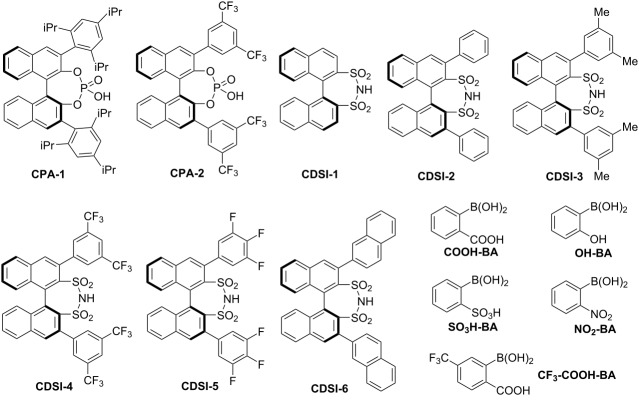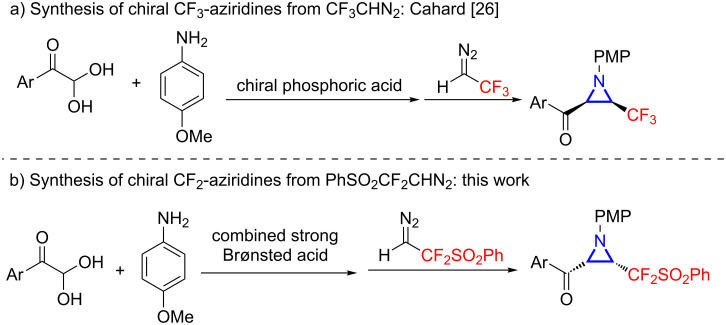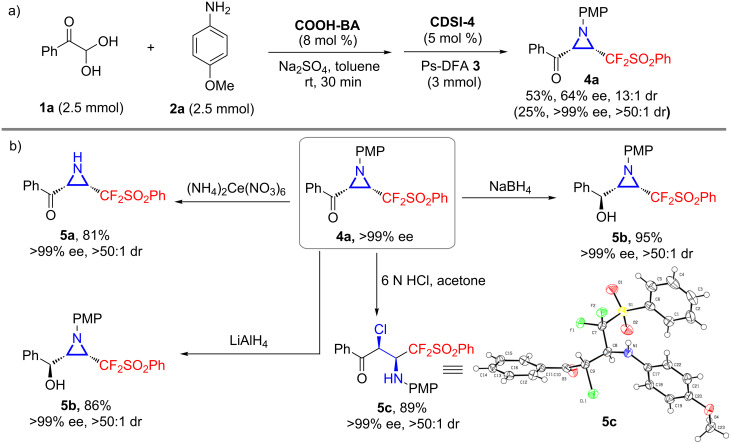Abstract
A diastereo- and enantioselective approach to access chiral CF2-functionalized aziridines from difluorodiazoethyl phenyl sulfone (PhSO2CF2CHN2) and in situ-formed aldimines is described. This multicomponent reaction is enabled by a combined strong Brønsted acid catalytic platform consisting of a chiral disulfonimide and 2-carboxyphenylboronic acid. The optical purity of the obtained CF2-substituted aziridines could be further improved by a practical dissolution–filtration procedure.
Keywords: aziridines, chiral disulfonimides, difluoromethyl compounds, fluorinated diazo reagents, strong Brønsted acids
Introduction
Chiral aziridines are prevalently found in natural products and artificially made bioactive molecules, thus receiving significant attention in the past decades [1–6]. Among them, the introduction of fluorine or fluoroalkyl groups into three-membered N-heterocycles has emerged as an attractive direction due to the unique fluorine effect in pharmaceuticals and biology [7–11]. In this context, it is not surprising that the syntheses of trifluoromethylaziridines have been pursued from versatile precursors [12–25]. However, catalytic asymmetric approaches to chiral CF3-functionalized aziridines have only been reported by Cahard in 2012, who utilized trifluorodiazoethane (CF3CHN2) as the nucleophile to react with aldimines catalyzed by chiral phosphoric acid (Scheme 1a) [26]. In comparison, there is a significant dearth of available synthetic approaches to CF2-functionalized aziridines, particularly in a stereocontrolled manner. Indeed, a handful of reported methods document the employment of difluoromethylimines, difluoromethyl phenyl sulfone, and difluoromethyl vinyl sulfonium salts as the fluorinating partner en route to various CF2-substituted aziridines [27–31], and a general protocol to chiral CF2-aziridines remains an unsolved challenge. Thus, herein we report a diastereo- and enantioselective aza-Darzens reaction between in situ-generated aldimines and our recently developed difluorodiazo reagent PhSO2CF2CHN2 acting as the difluorinated nucleophile [32–35], providing access to a variety of chiral CF2-fuctionalized aziridines under mild conditions (Scheme 1b). The key to this multicomponent transformation hinges upon the discovery of a combined strong Brønsted acid system comprised of a chiral disulfonimide and 2-carboxyphenylboronic acid.
Scheme 1.
Preparation of chiral aziridines from fluorinated diazo reagents.
Results and Discussion
We commenced the desired one-pot transformation by conducting the model reaction between phenylglyoxal monohydrate (1a), 4-methoxyaniline (2a), and PhSO2CF2CHN2 (3, Ps-DFA). Initial screenings were focused on the evaluation of various chiral phosphoric acids that have proven effective in similar aza-Darzens reactions of diazo esters and trifluorodiazoethane [36–39]. Unfortunately, these endeavors resulted in either no conversion or no enantioselectivity at all. As arylboronic acids have been harnessed to enhance the Brønsted acidity in asymmetric organocatalysis in combination with chiral diols or chiral aminoalcohols [40–44], we envisioned that the simultaneous use of arylboronic acids and chiral Brønsted acids may bring about a complementary catalytic platform. Encouragingly, the targeted CF2-functionalized aziridine 4a was obtained in up to 51% ee and high diastereoselectivity, albeit in a low yield (Table 1, entries 1 and 2). The difficulty in further improving the conversions might be ascribed to the limited Brønsted acidity of chiral phosphoric acids. Bearing this in mind, we then turned our attention to chiral disulfonimides developed by List, which have been established as a unique type of stronger Brønsted acids [45]. Putting it into practice, a range of BINOL-derived disulfonimides was used as the chiral additive in combination with 2-carboxyphenylboronic acid (COOH-BA) in the model reaction (Table 1, entries 3–8). We were pleased to find that CDSI-4 gave the most promising result in terms of both yield and enantioselectivity (64% isolated yield with 73% ee, Table 1, entry 6). An examination on various arylboronic acids, solvent, temperature, and catalyst loadings resulted in no obvious improvement (Table 1, entries 9–15). Among them, the highest yield of 4a was observed (81%, Table 1, entry 12), albeit with slightly reduced ee value. This enhancement in catalytic activity could be attributed to the increased Brønsted acidity when the strong electron-withdrawing trifluoromethyl group was placed on the benzene ring of the arylboronic acid. Removing the boronic acid from the reaction system leads to a dramatic decrease in both yield and enantiocontrol (Table 1, entry 16).
Table 1.
Representative screening results of the asymmetric aziridination reaction of PhSO2CF2CHN2.a
 | ||||
| entry | arylboronic acid (mol %) | chiral Brønsted acid (mol %) | yield of 4a (%)b | ee (%) of 4a and dr of crude mixturec |
| 1 | COOH-BA (8) | CPA-1 (5) | 24 | 51, 13:1 |
| 2 | COOH-BA (8) | CPA-2 (5) | 28 | 25, 11:1 |
| 3 | COOH-BA (8) | CDSI-1 (5) | 21 | 41, 19:1 |
| 4 | COOH-BA (8) | CDSI-2 (5) | 50 | 41, 9:1 |
| 5d | COOH-BA (8) | CDSI-3 (5) | 16 | 60, 5:1 |
| 6d | COOH-BA (8) | CDSI-4 (5) | 64 | 73, 13:1 |
| 7 | COOH-BA (8) | CDSI-5 (5) | 34 | 33, 10:1 |
| 8 | COOH-BA (8) | CDSI-6 (5) | 47 | 52, 9:1 |
| 9 | OH-BA (8) | CDSI-4 (5) | 63 | 68, 28:1 |
| 10d | SO3H-BA (8) | CDSI-4 (5) | 62 | 66, 16:1 |
| 11d | NO2-BA (8) | CDSI-4 (5) | 45 | 62, 16:1 |
| 12 | CF3-COOH-BA (8) | CDSI-4 (5) | 81 | 67, 8:1 |
| 13e | COOH-BA (8) | CDSI-4 (5) | 60 | 47, 5:1 |
| 14f | COOH-BA (8) | CDSI-4 (5) | trace | n.d. |
| 15d | COOH-BA (8) | CDSI-4 (10) | 65 | 70, 12:1 |
| 16d | – | CDSI-4 (5) | 10 | 60, >20:1 |

aGeneral reaction conditions: 1a (8 mg, 0.05 mmol, 1.0 equiv), 2a (7 mg, 0.055 mmol), arylboronic acid (0.004 mmol), and Na2SO4 (40 mg) was stirred in toluene (1 mL) at rt for 30 min, then the chiral Brønsted acid (0.0025 mmol) and 3 (18 mg, 0.075 mmol) were added and the mixture was reacted at rt for 12 hours unless otherwise noted; byield of isolated product 4a was given for entries labelled with d; hexafluorobenzene was used as an internal standard to determine the yield in other cases; cee of 4a was determined by chiral HPLC analysis, and the dr of the crude reaction mixture was probed by 19F NMR analysis; d0.3 mmol scale of reaction was conducted: 1a (46 mg, 0.3 mmol, 1.0 equiv), 2a (41 mg, 0.33 mmol), arylboronic acid (0.024 mmol), and Na2SO4 (200 mg) was stirred in toluene (2 mL) at rt for 30 min, then the chiral Brønsted acid (0.015 mmol) and 3 (105 mg, 0.45 mmol) were added and the mixture was reacted at rt for 12–24 hours; eCH2Cl2 was used as the solvent; freaction was operated at 0 °C.
The challenge to further improve the enantioselectivity promoted us to search for other practical solutions. Considering the poor solubility of 4a in organic solvents, a dissolution–filtration process with isopropanol was found to be workable for increasing the final ee value. This simple procedure could afford 4a with excellent enantiopurity as a single diastereoisomer (>99% ee, >50:1 dr, Scheme 2). By the aid of the developed one-pot aza-Darzens reaction and dissolution–filtration operation, a series of optically-pure CF2-aziridines 4b–h were furnished in moderate overall yields with uniformly excellent ee and dr values, including alkyl or halogen-substituted phenyl and 2-naphthyl ketones (Scheme 2). Unfortunately, phenylglyoxal monohydrates bearing strong electron-withdrawing groups were not compatible with the current conditions. X-ray analysis of aziridine 4a confirmed the absolute configuration of the chiral centers, pointing at a cis-aziridination process [46].
Scheme 2.
Substrate scope of chiral CF2-substituted aziridines from PhSO2CF2CHN2. General reaction conditions: Aryl glyoxal monohydrate (1, 0.3 mmol), 2a (41 mg, 0.33 mmol), COOH-BA (4 mg, 0.024 mmol), and Na2SO4 (200 mg) were stirred in toluene (2 mL) at rt for 30 min, then CDSI-4 (12 mg, 0.015 mmol) and Ps-DFA 3 (105 mg, 0.45 mmol) were added and the mixture was reacted at rt for 24 hours unless otherwise annotated. The yields are those of isolated products, and the dr was determined by 19F NMR analysis of the crude mixture. The results in parentheses are those of isolated products after the dissolution–filtration process: The corresponding CF2-functionalized aziridine 4 was dissolved in isopropanol (0.05–0.2 mL/mg) with the help of ultrasound, followed by filtration, and the obtained solution was concentrated to give 4 with increased ee and dr values. a0.006 mmol of COOH-BA was employed. bThe reaction was operated at 45 °C for 24 h.
Scaled-up experiments with model substrate 1a also proved to be feasible, delivering the chiral CF2-aziridine 4a with comparable results (Scheme 3a). The 4-methoxyphenyl group of 4a was cleaved smoothly with ceric ammonium nitrate, giving the free aziridine 5a in 81% yield while maintaining the ee value. The reduction of the carbonyl moiety with either NaBH4 or LiAlH4 produced hydroxy-substituted CF2-functionalized aziridine 5b in excellent yield with exclusive diastereoselectivity [47]. Furthermore, the ring-opening of 4a under acidic conditions underwent well and gave rise to CF2-functionalized α-chloro-β-amino ketone 5c in 89% yield with >99% ee and >50:1 dr (confirmed by X-ray spectroscopy) [46].
Scheme 3.
Scale-up experiment to 4a and further synthetic transformations.
Conclusion
In summary, an array of chiral CF2-functionalized aziridines was constructed from in situ-formed aldimines and difluorodiazoetyl phenyl sulfone under mild conditions by a combined strong Brønsted acid system consisting of chiral disulfonimide and 2-carboxyphenylboronic acid. The optical purity of the obtained CF2-substituted aziridines could be further improved by a practical dissolution–filtration procedure. Substrate expansion and mechanistic investigation are underway and will be reported in due course.
Experimental
General procedure for the preparation of chiral CF2-functionalized aziridines 4: To a 25 mL Schlenk tube equipped with a stirring bar were added 2,2-dihydroxy-1-arylethan-1-one (1, 0.3 mmol, 1 equiv), 4-methoxyaniline (2a, 40.6 mg, 0.33 mmol), 2-boronobenzoic acid (COOH-BA, 3.98 mg, 0.024 mmol), anhydrous Na2SO4 (200 mg) and toluene (1 mL) at room temperature under an argon atmosphere. After reacting for 30 minutes at room temperature, ((2-diazo-1,1-difluoroethyl)sulfonyl)benzene (Ps-DFA 3, 104.5 mg, 77.4 uL, 0.45 mmol) was added with a micro syringe and CDSI-4 (12.3 mg, 0.015 mmol) in toluene (1 mL) was added dropwise. The reaction was allowed to stir for 24 hours at room temperature under an argon atmosphere until the consumption of substrates was completed (as monitored by TLC). The reaction mixture was quenched with saturated aq NaHCO3 and extracted with ethyl acetate three times. The combined organic layer was washed with water and brine, and then dried over anhydrous Na2SO4, filtered and evaporated under vacuum. The residue was purified by neutral alumina column chromatography (eluting with dichloromethane/petroleum ether) to give CF2-substituted aziridine 4. The enantiomeric excess was determined by chiral HPLC analysis. See Supporting Information File 1 for the dissolution–filtration procedure for each compound.
Supporting Information
Experimental procedures, compound characterization, NMR spectra of all new compounds, and HPLC traces.
X-ray data for compound 4a.
X-ray data for compound 5c.
This article is part of the thematic issue "Organo-fluorine chemistry V".
Funding Statement
This work was supported by the National Key Research and Development Program of China (2019YFA0905100), National Natural Science Foundation of China (Nos. 21772142, 21901181, and 21961142015), and Tianjin Municipal Science & Technology Commission (19JCQNJC04700).
Contributor Information
Fa-Guang Zhang, Email: zhangfg1987@tju.edu.cn.
Jun-An Ma, Email: majun_an68@tju.edu.cn.
References
- 1.Tanner D. Angew Chem, Int Ed Engl. 1994;33:599–619. doi: 10.1002/anie.199405991. [DOI] [Google Scholar]
- 2.Sweeney J B. Chem Soc Rev. 2002;31:247–258. doi: 10.1039/b006015l. [DOI] [PubMed] [Google Scholar]
- 3.Singh G S, D'hooghe M, De Kimpe N. Chem Rev. 2007;107(5):2080–2135. doi: 10.1021/cr0680033. [DOI] [PubMed] [Google Scholar]
- 4.Sweeney J. Eur J Org Chem. 2009:4911–4919. doi: 10.1002/ejoc.200900211. [DOI] [Google Scholar]
- 5.Stanković S, D'hooghe M, Catak S, Eum H, Waroquier M, Van Speybroeck V, De Kimpe N, Ha H-J. Chem Soc Rev. 2012;41(2):643–665. doi: 10.1039/c1cs15140a. [DOI] [PubMed] [Google Scholar]
- 6.de los Santos J M, Ochoa de Retana A M, Martínez de Marigorta E, Vicario J, Palacios F. ChemCatChem. 2018;10(22):5092–5114. doi: 10.1002/cctc.201801026. [DOI] [Google Scholar]
- 7.Muller K, Faeh C, Diederich F. Science. 2007;317:1881–1886. doi: 10.1126/science.1131943. [DOI] [PubMed] [Google Scholar]
- 8.Ma J-A, Cahard D. Chem Rev. 2008;108:PR1–PR43. doi: 10.1021/cr800221v. [DOI] [PubMed] [Google Scholar]
- 9.Nie J, Guo H-C, Cahard D, Ma J-A. Chem Rev. 2011;111:455–529. doi: 10.1021/cr100166a. [DOI] [PubMed] [Google Scholar]
- 10.Meanwell N A. J Med Chem. 2018;61:5822–5880. doi: 10.1021/acs.jmedchem.7b01788. [DOI] [PubMed] [Google Scholar]
- 11.Rong J, Ni C, Hu J. Asian J Org Chem. 2017;6:139–152. doi: 10.1002/ajoc.201600509. [DOI] [Google Scholar]
- 12.Meyer F. Chem Commun. 2016;52:3077–3094. doi: 10.1039/c5cc09414c. [DOI] [PubMed] [Google Scholar]
- 13.Dolfen J, De Kimpe N, D’hooghe M. Synlett. 2016;27:1486–1510. doi: 10.1055/s-0035-1561379. [DOI] [Google Scholar]
- 14.Katagiri T, Ihara H, Takahashi M, Kashino S, Furuhashi K, Uneyama K. Tetrahedron: Asymmetry. 1997;8(17):2933–2937. doi: 10.1016/s0957-4166(97)00320-0. [DOI] [Google Scholar]
- 15.Colantoni D, Fioravanti S, Pellacani L, Tardella P A. Org Lett. 2004;6:197–200. doi: 10.1021/ol0361554. [DOI] [PubMed] [Google Scholar]
- 16.Maeda R, Ooyama K, Anno R, Shiosaki M, Azema T, Hanamoto T. Org Lett. 2010;12:2548–2550. doi: 10.1021/ol100768s. [DOI] [PubMed] [Google Scholar]
- 17.Künzi S A, Morandi B, Carreira E M. Org Lett. 2012;14:1900–1901. doi: 10.1021/ol300539e. [DOI] [PubMed] [Google Scholar]
- 18.Yang Y, Huang Y, Qing F-L. Tetrahedron Lett. 2013;54:3826–3830. doi: 10.1016/j.tetlet.2013.05.048. [DOI] [Google Scholar]
- 19.Dolfen J, Kenis S, Van Hecke K, De Kimpe N, D'hooghe M. Chem – Eur J. 2014;20(34):10650–10653. doi: 10.1002/chem.201304759. [DOI] [PubMed] [Google Scholar]
- 20.Wang F, Zhu N, Chen P, Ye J, Liu G. Angew Chem, Int Ed. 2015;54:9356–9360. doi: 10.1002/anie.201503412. [DOI] [PubMed] [Google Scholar]
- 21.Duan Y, Zhou B, Lin J-H, Xiao J-C. Chem Commun. 2015;51:13127–13130. doi: 10.1039/c5cc04991a. [DOI] [PubMed] [Google Scholar]
- 22.Huang Y-J, Qiao B, Zhang F-G, Ma J-A. Tetrahedron. 2018;74:3791–3796. doi: 10.1016/j.tet.2018.05.033. [DOI] [Google Scholar]
- 23.Mészáros Á, Székely A, Stirling A, Novák Z. Angew Chem, Int Ed. 2018;57:6643–6647. doi: 10.1002/anie.201802347. [DOI] [PubMed] [Google Scholar]
- 24.Thi H D, Thuy G L N, Catak S, Van Speybroeck V, Nguyen T V, D’hooghe M. Synthesis. 2018;50:1439–1456. doi: 10.1055/s-0036-1591537. [DOI] [Google Scholar]
- 25.Wu K, Zhou C-Y, Che C-M. Org Lett. 2019;21:85–89. doi: 10.1021/acs.orglett.8b03514. [DOI] [PubMed] [Google Scholar]
- 26.Chai Z, Bouillon J-P, Cahard D. Chem Commun. 2012;48:9471–9473. doi: 10.1039/c2cc35246j. [DOI] [PubMed] [Google Scholar]
- 27.Mae M, Matsuura M, Amii H, Uneyama K. Tetrahedron Lett. 2002;43:2069–2072. doi: 10.1016/s0040-4039(02)00205-8. [DOI] [Google Scholar]
- 28.Palacios F, Ochoa de Retana A M, Alonso J M. J Org Chem. 2006;71(16):6141–6148. doi: 10.1021/jo060865g. [DOI] [PubMed] [Google Scholar]
- 29.Liu J, Hu J. Chem – Eur J. 2010;16:11443–11454. doi: 10.1002/chem.201000893. [DOI] [PubMed] [Google Scholar]
- 30.Kurosato F, Ishikawa T, Yamada Y, Hanamoto T. Synlett. 2015;26:1827–1830. doi: 10.1055/s-0034-1381008. [DOI] [Google Scholar]
- 31.Zhang W, Wang X, Zhu B, Zhu D, Han J, Wzorek A, Sato A, Soloshonok V A, Zhou J, Pan Y. Adv Synth Catal. 2017;359:4267–4273. doi: 10.1002/adsc.201701066. [DOI] [Google Scholar]
- 32.Zeng J-L, Chen Z, Zhang F-G, Ma J-A. Org Lett. 2018;20:4562–4565. doi: 10.1021/acs.orglett.8b01854. [DOI] [PubMed] [Google Scholar]
- 33.Peng X, Xiao M-Y, Zeng J-L, Zhang F-G, Ma J-A. Org Lett. 2019;21:4808–4811. doi: 10.1021/acs.orglett.9b01697. [DOI] [PubMed] [Google Scholar]
- 34.Zeng J-L, Zhang Y, Zheng M-M, Zhang Z-Q, Xue X-S, Zhang F-G, Ma J-A. Org Lett. 2019;21:8244–8249. doi: 10.1021/acs.orglett.9b02989. [DOI] [PubMed] [Google Scholar]
- 35.Zhang Z-Q, Zheng M-M, Xue X-S, Marek I, Zhang F-G, Ma J-A. Angew Chem, Int Ed. 2019;58:18191–18196. doi: 10.1002/anie.201911701. [DOI] [PubMed] [Google Scholar]
- 36.Zhang Y, Wang J. Chem Commun. 2009:5350–5361. doi: 10.1039/b908378b. [DOI] [PubMed] [Google Scholar]
- 37.Zhang Y, Lu Z, Wulff W D. Synlett. 2009:2715–2739. doi: 10.1055/s-0029-1217979. [DOI] [Google Scholar]
- 38.Pellissier H. Adv Synth Catal. 2014;356:1899–1935. doi: 10.1002/adsc.201400312. [DOI] [Google Scholar]
- 39.Liu Y. Curr Org Chem. 2016;20:19–28. doi: 10.2174/1385272819666150810225618. [DOI] [Google Scholar]
- 40.Yamamoto H, Futatsugi K. Angew Chem, Int Ed. 2005;44:1924–1942. doi: 10.1002/anie.200460394. [DOI] [PubMed] [Google Scholar]
- 41.Dimitrijević E, Taylor M S. ACS Catal. 2013;3(5):945–962. doi: 10.1021/cs4000848. [DOI] [Google Scholar]
- 42.Hashimoto T, Gálvez A O, Maruoka K. J Am Chem Soc. 2013;135(47):17667–17670. doi: 10.1021/ja407764u. [DOI] [PubMed] [Google Scholar]
- 43.Huang B, He Y, Levin M D, Coelho J A S, Bergman R G, Toste F D. Adv Synth Catal. 2020;362:295–301. doi: 10.1002/adsc.201900816. [DOI] [PMC free article] [PubMed] [Google Scholar]
- 44.Zhang Q-X, Li Y, Wang J, Yang C, Liu C-J, Li X, Cheng J-P. Angew Chem, Int Ed. 2020;59:4550–4556. doi: 10.1002/anie.201915226. [DOI] [PubMed] [Google Scholar]
- 45.James T, van Gemmeren M, List B. Chem Rev. 2015;115(17):9388–9409. doi: 10.1021/acs.chemrev.5b00128. [DOI] [PubMed] [Google Scholar]
- 46.CCDC 1983642 (4a) and 1983643 (5c) contain the supplementary crystallographic data. The crystallographic data can be obtained free of charge via http://www.ccdc.cam.ac.uk/data_request/cif. It should be mentioned that the stereochemistry of 3-CF2-aziridines in this reaction (2R,3S) are opposite to that of 3-CF3-aziridines (2S,3R) in Cahard’s report ([26]). We hypothesized that the enantiodetermining step in our reaction might be controlled through an in situ formed chiral boronate complex from chiral disulfonimide and 2-carboxyphenylboronic acid. Further efforts to improve the level of stereoselectivity and detailed mechanistic elucidation are still undergoing in our lab.
- 47.The stereochemistry of compound 5b was determined based on the 1H NMR, 19F NMR, and 2D NOE analysis. In the 2D NOE spectrum, the correlation between HO (4.83 ppm) and HC–N (2.7 ppm) was observed, whereas no correlation between HC–O (3.7 ppm) and HC–CF2 (3.02 ppm) was found.
Associated Data
This section collects any data citations, data availability statements, or supplementary materials included in this article.
Supplementary Materials
Experimental procedures, compound characterization, NMR spectra of all new compounds, and HPLC traces.
X-ray data for compound 4a.
X-ray data for compound 5c.





